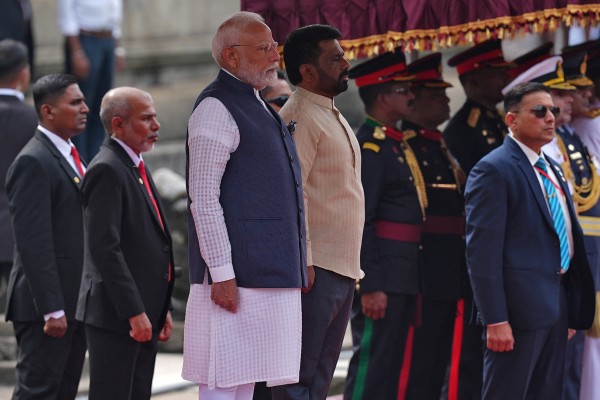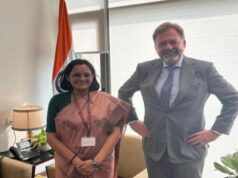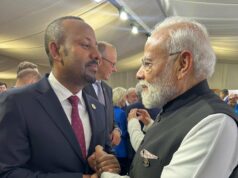
Prime Minister Narendra Modi’s visit to Sri Lanka from April 4–6, 2025, was historic in more ways than one.
It marked his fourth visit to the island nation, but more importantly, Modi was the first foreign leader to visit Sri Lanka since the election of President Anura Kumara Dissanayake (AKD) and the installation of a new National People’s Power (NPP) government.
The optics were unmistakably strong: from joint car rides between Colombo and Anuradhapura to the viral photo of the two leaders sipping Tambili (king coconut water) during Navratri, this was diplomacy with a personal touch.
Prime Minister Modi was even conferred the Mitra Vibhooshana, Sri Lanka’s highest civilian honour for a foreign leader — a symbolic endorsement of the warmth between the two administrations.
For the new AKD administration, often painted as inexperienced in statecraft and diplomacy, managing such a high-stakes visit was a public relations success. “Narendra Modi has endorsed and validated AKD,” a corporate executive told me. “The chemistry between the two was undeniable.”
Given the Janatha Vimukthi Peramuna’s (JVP) historic suspicion of India — a legacy that shadows the NPP — this visit helped dispel some of that baggage.
From India’s perspective, the visit served a deeper strategic purpose: recalibrating ties with a new leadership that has traditionally kept New Delhi at arm’s length. The two countries signed 10 agreements, including a landmark MoU on Defence Cooperation — the first of its kind between India and Sri Lanka — formalising years of informal defence collaboration.
Also notable were deals to expand solar energy, digital transformation, and discussions around linking the power grids of the two countries.
India also converted $100 million of loans into outright grants, a gesture that signals goodwill and solidarity with a neighbour still recovering from an unprecedented economic collapse.
And yet, for all the symbolism and pageantry, the most critical component of the relationship was missing: a clear, bold economic agenda.
Sri Lanka is clawing its way out of a severe economic crisis, with an IMF lifeline providing some short-term stability. But recovery demands more — specifically, foreign direct investment (FDI), market access, and infrastructure development. This was a golden opportunity to anchor Sri Lanka’s future to the engine of India’s economic rise. And it wasn’t seized.
There was no major bilateral economic breakthrough, no surprise announcement, no bold vision for leveraging India’s growth for Sri Lanka’s recovery. For many of us who expected a deeper economic pivot, it was a missed moment.
Why was the economic element so conspicuously absent? There could be several reasons:
- Upcoming Local Elections: With polls scheduled for May 6, the AKD government may have feared political backlash from overt economic engagements with India, which could be spun by the opposition as compromising sovereignty.
- Old Ideological Residues: The JVP, despite AKD’s pragmatism, still harbours deep-rooted suspicions about Indian economic influence. Shifting this mindset takes time.
- Cautious Governance Style: AKD’s team has so far shown a methodical and deliberate approach. It is possible they’re simply taking their time before committing to large-scale economic deals with India.Meanwhile, AKD’s second foreign trip was to China, where he secured a $3.7 billion investment and publicly hailed China as Sri Lanka’s “most trusted” economic partner. That statement was widely circulated on Chinese state media — and widely noticed in Indian policy circles.
If Sri Lanka is serious about leveraging its proximity to India, several imperatives must move forward:
- Expedite the ETCA: The Economic and Technology Cooperation Agreement has seen 14 rounds of talks. It’s time to move toward closure.
- Build All-Round Connectivity: Physical and digital integration with India could be transformative for trade, tourism, and energy exchange.
- Explore Indian Market Access: Particularly for sectors like garments, which are reeling from U.S. tariffs, India can offer a near-market opportunity.
Interestingly, former President Mahinda Rajapaksa and Prime Minister Modi shared tweets referencing the historical, cultural, and spiritual ties between the two nations.
Mahinda Rajapaksa: “Welcoming PM Narendra Modi to our island. May the spiritual and cultural bonds grow stronger.”
Narendra Modi: “Sri Lanka and India share deep-rooted civilisational links. Glad to visit once again.”
Notably, neither mentioned economic ties — an omission that stood out starkly given the pressing needs of the hour.
Sri Lanka can no longer afford to treat India as just a civilisational cousin while courting China as the “trusted” economic partner. When the crisis hit, India was the first responder — with scale, speed, and sincerity. It is time for Sri Lanka to view India not just as a neighbour with shared history, but as a strategic economic ally for the future.
The missing economic piece in this otherwise successful diplomatic puzzle must be placed — urgently and deliberately.
Santosh Menon is the President of Lanka India Business Association- LIBA and can be reached at president@liba.lk
For more information on LIBA go to www.liba.lk




